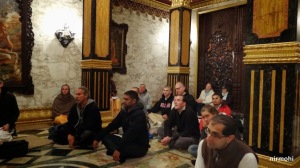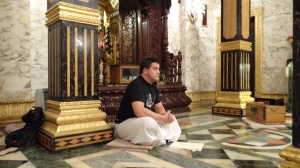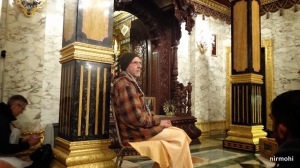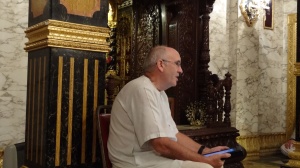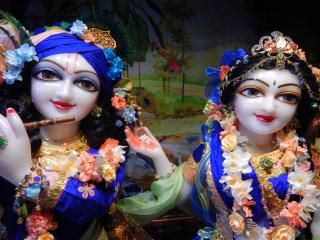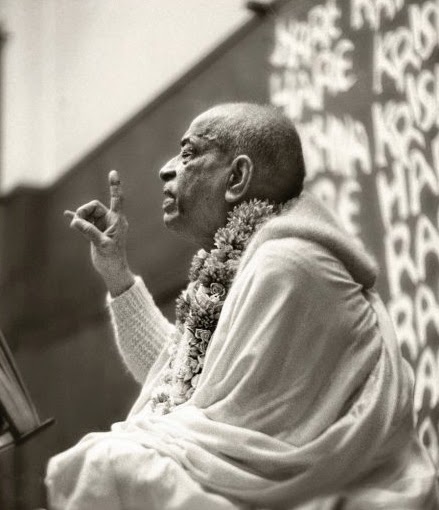I write a journal daily (well, almost daily) and sometimes when I can’t think of anything to write, I just type “Thank you, Krishna …” and let my fingers move on the keyboard. I thank Krishna for whatever good things have happened in my life. I thank him for whatever good ideas I have got for my writing, because writing is my main service and I can’t write without ideas. And I thank him for whatever good service I was able to do, being grateful that whatever needed to go right for doing that service did in fact turn out right and the many things that could have gone wrong didn’t go wrong.
As my fingers move thus, I am often surprised at how easily I meet my daily journal quota (I try to write at least 500 words daily). More importantly, by writing about my thankfulness, I start feeling thankful. Even more importantly, I notice many things to be thankful for – things that I had overlooked while being caught in the rush of life. I find it revealing how just the attempt to thank, more specifically the attempt to express that thanks through verbalization, nourishes the attitude of gratitude. Such nourishment inspires me to cherish journaling as a daily devotional ritual.
Rituals provide a stimulus and structure for expressing and thereby experiencing refined emotions.
Nourishing our higher side is, in fact, the purpose of rituals. They provide a stimulus and structure for expressing and thereby experiencing refined emotions. Rituals may be private such as journaling or public such as the festival of Thanksgiving being celebrated in America and elsewhere this week.
From form to substance
Being born and brought up in India where Thanksgiving is hardly celebrated, I hadn’t even heard about it before I was introduced to bhakti-yoga. The Christian festivals I knew from my convent education were Christmas and Easter. After my initiation into the bhakti tradition, when I studied other traditions, I read about Thanksgiving for the first time. My initial impression was negative as the celebration included killing and eating of turkeys. Killing a creature to thank the Creator struck me as bizarre and counter-devotional.
Nonetheless, putting aside that initial impression, I read more about the festival. And I found that its essential spirit was good – the spirit of expressing gratitude. No doubt, Thanksgiving is often reduced to just an occasion for having a good time. But such degeneration of meaningful festivals to mere fun can happen to any festival, even widely celebrated ones such as Christmas and Diwali, whose celebrants hardly ponder its spiritual significance. Still, many people do celebrate Thanksgiving as a heartfelt expression of their gratitude to God, the ultimate giver of everything, for the many gifts they have been blessed with. Thankfully, we live in times of increasing awareness of animal rights. And we are also more scientifically aware of the feasibility, even the preferability, of vegetarianism as a dietary choice. So we can hope that progressive celebrants of Thanksgiving will find non-violent alternatives to turkeys for expressing their gratitude. Instead of eating the turkey, they need to talk turkey. That is, they need to discuss seriously the principle and the practice of Thanksgiving.
We can hope that progressive celebrants of Thanksgiving will find non-violent alternatives to turkeys for expressing their gratitude. Instead of eating the turkey, they need to talk turkey.
Nothing to thank for?
The principle of gratitude to God is a universally enshrined in the world’s religious traditions. Sadly however, the gratitude that is universally endorsed is becoming universally elusive, thanks to today’s materialistic culture.
Materialism makes us believe we can find happiness only in material things – the more things we have, the happier we will be. So, we become obsessed with getting more and more things. What aggravates our obsession is the aggressive advertising industry, which parades before us the many things we don’t have, thereby inflaming our desires for them. When we are thus obsessed with what we don’t have, we often don’t even notice what we have, leave alone feel grateful for it.
Gratitude is much easier to cultivate with a more spiritual vision of life, wherein we recognize that real happiness comes not through outer acquisition but through inner realization. The Bhagavad-gita is an ancient yoga text that shares such a spiritual vision. Its central message is that we are at our core souls, who can find supreme fulfillment in spiritual love for God, Krishna.
The most thankworthy blessing
With such a spiritual vision of life, what all can we be thankful for?
Amidst the death and disaster and destruction prevalent in the world today, that we are alive is itself thankworthy. Beyond that we can be thankful for having life’s necessities, which so many people don’t have. The most important thing to be thankful for, however, is having a purpose for living. I refer not to the material purpose that we may adopt but to the spiritual purpose of living – the reason we exist.
Gita wisdom reveals that purpose to be love – love for God and for all living beings in relationship with him. Such spiritual love brings the supreme value to our life. It provides not just real meaning and deep fulfillment in this life but also makes this life into a launching pad to immorality. How? By raising our consciousness from the material level, where we suffer death due to the mortality of our bodily shell, to the spiritual level, where we realize the indestructibility of our spiritual core.
The opportunity to perceive and pursue this paramount purpose of life is supremely thankworthy. God offers us this opportunity through scripture and through the living traditions that strive to live according to scripture. The Bhagavad-gita (07.03) indicates that those who grab this opportunity for spiritual enlightenment are special souls, being one among thousands.
Being thankful amidst adversity
Those who embrace life’s spiritual purpose are thankful to God not just for good things, but also for bad things. A prominent bhakti text, Srimad Bhagavatam (10.14.08), features a celebrated prayer that responds to adversity by thanking God with folded hands and bowed head. Significantly, the prayer concludes with the bold, confident declaration that those who can be thus thankful become rightful inheritors of life eternal. The rationale for this declaration is understandable – to be grateful amidst material losses, we need to fix our heart on our spiritual gifts. And such spiritual redirection of the heart is the pathway for attaining a life of eternal love with our eternal Lord.
Amidst the complexity of life and even of religion in a multi-cultural world, Thanksgiving can remind us of the striking simplicity with which we can go closer to God: by saying a heartfelt “Thank you.”







